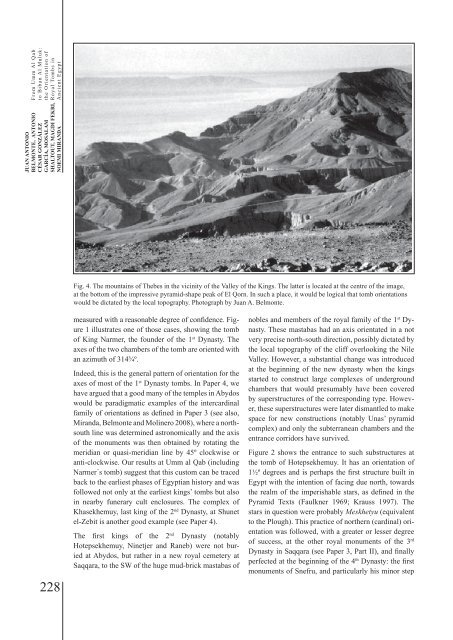BALTICA10
BALTICA10
BALTICA10
You also want an ePaper? Increase the reach of your titles
YUMPU automatically turns print PDFs into web optimized ePapers that Google loves.
Juan Antonio<br />
Belmonte, Antonio<br />
César González<br />
García, Mosalam<br />
Shaltout, Magdi Fekri,<br />
Noemi Miranda<br />
From Umm Al Qab<br />
to Biban Al Muluk:<br />
the Orientation of<br />
Royal Tombs in<br />
Ancient Egypt<br />
Fig. 4. The mountains of Thebes in the vicinity of the Valley of the Kings. The latter is located at the centre of the image,<br />
at the bottom of the impressive pyramid-shape peak of El Qorn. In such a place, it would be logical that tomb orientations<br />
would be dictated by the local topography. Photograph by Juan A. Belmonte.<br />
228<br />
measured with a reasonable degree of confidence. Figure<br />
1 illustrates one of those cases, showing the tomb<br />
of King Narmer, the founder of the 1 st Dynasty. The<br />
axes of the two chambers of the tomb are oriented with<br />
an azimuth of 314¾º.<br />
Indeed, this is the general pattern of orientation for the<br />
axes of most of the 1 st Dynasty tombs. In Paper 4, we<br />
have argued that a good many of the temples in Abydos<br />
would be paradigmatic examples of the intercardinal<br />
family of orientations as defined in Paper 3 (see also,<br />
Miranda, Belmonte and Molinero 2008), where a northsouth<br />
line was determined astronomically and the axis<br />
of the monuments was then obtained by rotating the<br />
meridian or quasi-meridian line by 45º clockwise or<br />
anti-clockwise. Our results at Umm al Qab (including<br />
Narmer´s tomb) suggest that this custom can be traced<br />
back to the earliest phases of Egyptian history and was<br />
followed not only at the earliest kings’ tombs but also<br />
in nearby funerary cult enclosures. The complex of<br />
Khasekhemuy, last king of the 2 nd Dynasty, at Shunet<br />
el-Zebit is another good example (see Paper 4).<br />
The first kings of the 2 nd Dynasty (notably<br />
Hotepsekhemuy, Ninetjer and Raneb) were not buried<br />
at Abydos, but rather in a new royal cemetery at<br />
Saqqara, to the SW of the huge mud-brick mastabas of<br />
nobles and members of the royal family of the 1 st Dynasty.<br />
These mastabas had an axis orientated in a not<br />
very precise north-south direction, possibly dictated by<br />
the local topography of the cliff overlooking the Nile<br />
Valley. However, a substantial change was introduced<br />
at the beginning of the new dynasty when the kings<br />
started to construct large complexes of underground<br />
chambers that would presumably have been covered<br />
by superstructures of the corresponding type. However,<br />
these superstructures were later dismantled to make<br />
space for new constructions (notably Unas’ pyramid<br />
complex) and only the subterranean chambers and the<br />
entrance corridors have survived.<br />
Figure 2 shows the entrance to such substructures at<br />
the tomb of Hotepsekhemuy. It has an orientation of<br />
1½º degrees and is perhaps the first structure built in<br />
Egypt with the intention of facing due north, towards<br />
the realm of the imperishable stars, as defined in the<br />
Pyramid Texts (Faulkner 1969; Krauss 1997). The<br />
stars in question were probably Meskhetyu (equivalent<br />
to the Plough). This practice of northern (cardinal) orientation<br />
was followed, with a greater or lesser degree<br />
of success, at the other royal monuments of the 3 rd<br />
Dynasty in Saqqara (see Paper 3, Part II), and finally<br />
perfected at the beginning of the 4 th Dynasty: the first<br />
monuments of Snefru, and particularly his minor step
















